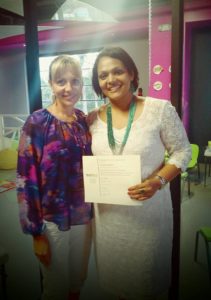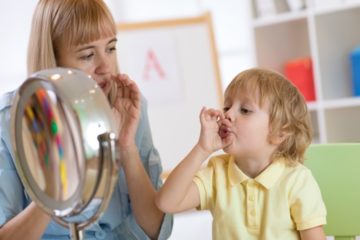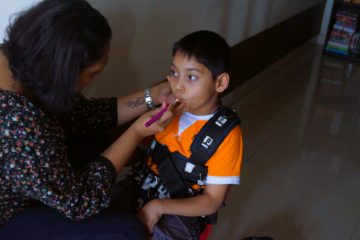
Shereen Idiculla receiving level 3 OPT certification
My OPT journey started more than a decade ago in Singapore when I was still a newbie at work. I had heard of Sara’s technique and had an opportunity to talk to one of my colleagues about the program that she had attended and how it had benefited her as a speech therapist. When I finally got an opportunity to learn more about this program in 2010, it was an eye-opener and there was no looking back after that! I had been certified for Hanen’s It Takes Two To Talk Program, but making a child verbal when their speech was unclear was something I wasn’t having much success with. It was when I started my journey with Oral Placement Therapy that I realized that there was a chunk of information that was missing from my therapy approach.
It took me a while to put the information I learned from the courses conducted by Sara Rosenfeld-Johnson, Lori Overland and Renee Roy Hill into perspective and gradually make it a part of my regular speech therapy sessions. Even when I completed my Level 3 certification, I realised there was still so much to learn. However, now when children come to me, I can figure out why ‘speech’ hasn’t developed or why the child is facing feeding issues, and convince parents that working on feeding issues will help the child develop speech and work towards speech in a non-traditional but effective way.
“Oral Placement Therapy or OPT for speech teaches oral structural placements to clients who cannot produce or imitate speech sounds using traditional auditory or visual input. For these clients, it is critical to expand speech sound production from phonemes and other similar oral movements the client can already produce. Once a client can produce a targeted speech sound using traditional auditory or visual input, speech therapy can progress in a more typical manner. OPT is only a small part of comprehensive speech and language program and should not be done in isolation. The activities are carefully selected to stimulate the same movements used in the targeted speech production. They can be completed in under 15 minutes and can be used to refocus attention and concentration from a sensory processing perspective.”
(Excerpt from “Oral Placement Therapy for Speech Clarity and Feeding”, authored by Sara Rosenfeld-Johnson)
After practising OPT for over six years, it is easy now to make sure a child with communication difficulties gets a holistic program that involves a ‘speech’ component, a ‘language’ component and a ‘communication’ component. But unfortunately, the current trends show me two main challenges. One, the speech therapists who are certifying themselves in the same don’t always combine OPT into a holistic speech and language program, making it ineffective and, two, parents of children with special needs seem to think OPT is THE program to get the child to talk. Hence, they wait for ‘speech’ to develop to get communication going, thinking that any form of AAC (Alternative and Augmentative form of Communication) will impede speech development. I don’t remember the number of times I have had to talk to parents to make them understand the importance of Communication over speech, to lessen the child’s frustration with the parent’s demand for speech.
OPT, as Sara mentioned earlier, is NOT a program to be done in isolation. It is a process that starts the neurons firing in the brain to create motor movements that are needed for speech and feeding, using tactile stimulation. But for speech to develop into language and communication, traditional approaches will need to be used, with the help of AAC. If the demand for speech is so high, and something the child is not able to achieve however hard he/she tries (especially in cases of childhood apraxia of speech), then ‘speech’ becomes tied to a negative emotion, and the result is crying, screaming, tantrums or meltdowns, the minute ‘speech activities’ are started or practised. This is why it is important that we need to focus on communication first, work on OPT simultaneously to create appropriate motor movements, relax the child, help him/her self-regulate and then introduce speech into his communication program, as the motor movements improve.
Therefore, OPT is an absolutely fantastic program as it builds a bridge between Speech and Communication.
Common mistakes I see therapists make include:
- Not following the criteria of success, and hence making the program ineffective as the child tends to fail later in the program
- Not following the rationale behind the OPT program to develop speech
- Not connecting the motor movements created to speech, especially for children with childhood apraxia of speech.
- Not connecting the motor movements created during feeding to speech
- Picking random activities and not following a hierarchy, thus making the program ineffective
Common problems parents face when trying the OPT program:
- Cost of the tools, hence reluctance to follow through the program
- Appropriate guidance to move through the program in a correct manner
- Unavailability of OPT therapists
- Not understanding the rationale behind the activities, hence getting demotivated and inconsistent in the home program.
In a nutshell, OPT is an excellent program, but not if it is done in isolation. My experience with working with this program and other approaches like Hanen and RDI, have taught me the importance of combining these approaches to make it the best program for a child with communication difficulties. I have to stress that any speech and language program for a child should, must and needs to combine Speech, Language and Communication components to make it an effective one.



2 Comments
Meera · August 5, 2024 at 3:46 pm
My daughter has her tongue out most times and struggles with certain pronounciations. I am interested in online therapy for her. We are living in Thiruvanamalai.
Would you be able to help her?
Urban Lens · September 19, 2024 at 6:03 pm
Thank you for the detailed insights on using oral placement therapy effectively. Your explanation of how oral placement therapy can be tailored to meet individual needs is incredibly valuable for both therapists and parents. The practical tips and strategies you’ve shared will undoubtedly help in implementing this therapy to improve speech and feeding skills. I appreciate the clarity and depth of your guidance—this is a fantastic resource for anyone working with oral placement therapy!